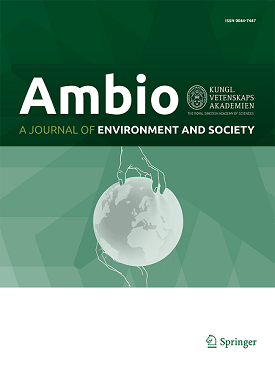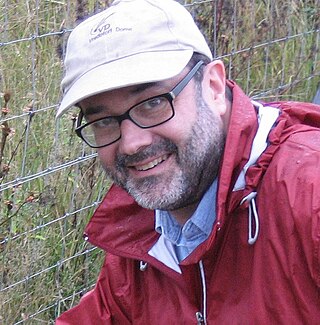
Meteor Crater or Barringer Crater is a meteorite impact crater about 37 mi (60 km) east of Flagstaff and 18 mi (29 km) west of Winslow in the desert of northern Arizona, United States. The site had several earlier names, and fragments of the meteorite are officially called the Canyon Diablo Meteorite, after the adjacent Cañon Diablo.

Monthly Notices of the Royal Astronomical Society (MNRAS) is a peer-reviewed scientific journal covering research in astronomy and astrophysics. It has been in continuous existence since 1827 and publishes letters and papers reporting original research in relevant fields. Despite the name, the journal is no longer monthly, nor does it carry the notices of the Royal Astronomical Society.

Planetary geology, alternatively known as astrogeology or exogeology, is a planetary science discipline concerned with the geology of celestial bodies such as planets and their moons, asteroids, comets, and meteorites. Although the geo- prefix typically indicates topics of or relating to Earth, planetary geology is named as such for historical and convenience reasons; due to the types of investigations involved, it is closely linked with Earth-based geology. These investigations are centered around the composition, structure, processes, and history of a celestial body.
George Wetherill was a physicist and geologist and the director emeritus of the department of terrestrial magnetism at the Carnegie Institution of Washington, DC, US.
Susan Elizabeth Werner Kieffer is an American physical geologist and planetary scientist. Kieffer is known for her work on the fluid dynamics of volcanoes, geysers, and rivers, and for her model of the thermodynamic properties of complex minerals. She has also contributed to the scientific understanding of meteorite impacts.

James F. Bell III is a professor of Astronomy at Arizona State University, specializing in the study of planetary geology, geochemistry and mineralogy using data obtained from telescopes and from various spacecraft missions. Bell's active research has involved the NASA Mars Pathfinder, Near Earth Asteroid Rendezvous (NEAR), Comet Nucleus Tour (CONTOUR), 2001 Mars Odyssey, Mars Reconnaissance Orbiter, Lunar Reconnaissance Orbiter, and the Mars Science Laboratory missions. His book Postcards from Mars includes many images taken by the Mars rovers. Bell is currently an editor of the space science journal Icarus and president of The Planetary Society. He has served as the lead scientist in charge of the Panoramic camera (Pancam) color imaging system on Mars rovers Spirit and Opportunity.

Annual Review of Earth and Planetary Sciences is an annual peer-reviewed scientific journal published by Annual Reviews, which broadly covers Earth and planetary sciences, including geology, atmospheric sciences, climate, geophysics, environmental science, geological hazards, geodynamics, planet formation, and solar system origins. The co-editors are Katherine H. Freeman and Raymond Jeanloz. As of 2023, Journal Citation Reports gives the journal a 2022 impact factor of 14.9. As of 2023, it is being published as open access, under the Subscribe to Open model.

Ambio: A Journal of Environment and Society is a monthly peer-reviewed scientific journal published by Springer Science+Business Media on behalf of the Royal Swedish Academy of Sciences. It was established in 1972. The editor-in-chief is Bo Söderström. It covers research concerning the human environment, including ecology, environmental economics, geology, geochemistry, geophysics, physical geography, human geography, paleontology, hydrology, water resources, oceanography, Earth sciences, meteorology, and other subjects.

Geochimica et Cosmochimica Acta is a biweekly peer-reviewed scientific journal published by Elsevier. It was established in 1950 and is sponsored by the Geochemical Society and the Meteoritical Society. The editor-in-chief is Jeffrey Catalano. The journal covers topics in Earth geochemistry, planetary geochemistry, cosmochemistry and meteoritics.

Astronomy & Geophysics (A&G) is a scientific journal and trade magazine published on behalf of the Royal Astronomical Society (RAS) by Oxford University Press. It is distributed bimonthly to members of the RAS.

Geophysical Journal International (GJI) is a monthly peer-reviewed scientific journal in the field of geophysics. It is published by Oxford University Press on behalf of two learned societies: the Royal Astronomical Society (RAS) and the Deutsche Geophysikalische Gesellschaft, who select and peer-review the contents.

Physics of the Earth and Planetary Interiors, established in October 1967, is a biweekly peer-reviewed scientific journal published by Elsevier. The co-editors are A. Ferreira, K. Hirose, D. Jault, and C. Michaut.

Christian Köberl is a professor of impact research and planetary geology at the University of Vienna, Austria. From June 2010 to May 2020 he was director general of the Natural History Museum in Vienna. He is best known for his research on meteorite impact craters.
Geostandards and Geoanalytical Research is a quarterly peer-reviewed scientific journal covering reference materials, analytical techniques, and data quality relevant to the chemical analysis of geological and environmental samples. The journal was established in 1977 as Geostandards Newsletter and modified its title in 2004. The editors-in-chief are Thomas C. Meisel, Jacinta Enzweiler, Mary F. Horan, Kathryn L. Linge, Christophe R. Quétel and Paul J. Sylvester. It is published by Wiley-Blackwell on behalf of the International Association of Geoanalysts. The journal is a hybrid open-access journal, publishing both subscription and open access articles.

Planetary science is the scientific study of planets, celestial bodies and planetary systems and the processes of their formation. It studies objects ranging in size from micrometeoroids to gas giants, aiming to determine their composition, dynamics, formation, interrelations and history. It is a strongly interdisciplinary field, which originally grew from astronomy and Earth science, and now incorporates many disciplines, including planetary geology, cosmochemistry, atmospheric science, physics, oceanography, hydrology, theoretical planetary science, glaciology, and exoplanetology. Allied disciplines include space physics, when concerned with the effects of the Sun on the bodies of the Solar System, and astrobiology.
Publications of the Astronomical Society of Australia is a peer-reviewed scientific journal covering all aspects of astrophysics and astronomy. The editor-in-chief is Ivo Rolf Seitenzahl. It was established in 1967 and is published by Cambridge University Press on behalf of the Astronomical Society of Australia.
Geochemistry, Geophysics, Geosystems is a peer-reviewed open-access scientific journal covering research in Earth and planetary processes with a focus on understanding the Earth as a system. The journal is published by Wiley on behalf of the American Geophysical Union. As of May 2022 the editor-in-chief is Claudio Faccenna.
Katharina Lodders is a German-American planetary scientist and cosmochemist who works as a research professor in the Department of Earth and Planetary Sciences at Washington University in St. Louis, where she co-directs the Planetary Chemistry Laboratory. Her research concerns the chemical composition of solar and stellar environments, including the atmospheres of planets, exoplanets, and brown dwarfs, and the study of the temperatures at which elements condense in stellar environments.











